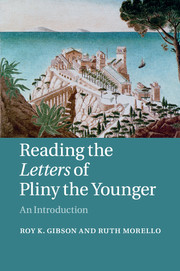Reading the Letters of Pliny the Younger An Introduction
Langue : Anglais
Auteurs : Gibson Roy K., Morello Ruth

This is the first general introduction to Pliny's Letters published in any language, combining close readings with broader context.
This is the first general introduction to Pliny's Letters published in any language, combining close readings with broader context and adopting a fresh and innovative approach to reading the letters as an artistically structured collection. Chapter 1 traces Pliny's autobiographical narrative throughout the Letters; Chapter 2 undertakes detailed study of Book 6 as an artistic entity; while Chapter 3 sets Pliny's letters within a Roman epistolographical tradition dominated by Cicero and Seneca. Chapters 4 to 7 study thematic letter cycles within the collection, including those on Pliny's famous country villas and his relationships with Pliny the Elder and Tacitus. The final chapter focuses on the 'grand design' which unifies and structures the collection. Four detailed appendices give invaluable historical and scholarly context, including a helpful timeline for Pliny's life and career, detailed bibliographical help on over 30 popular topics in Pliny's letters and a summary of the main characters mentioned in the Letters.
Introduction; 1. Reading a life: Letters, Book 1; 2. Reading a book: Letters, Book 6; 3. Epistolary models: Cicero and Seneca; 4. Pliny's elders and betters: the Elder Pliny, Vestricius Spurinna, Corellius Rufus, Verginius Rufus; 5. Pliny's peers: reading for the addressee; 6. Otium: how to manage leisure; 7. Reading the Villa Letters: 9.7, 2.17, 5.6; 8. The grand design: how to read a collection; Appendix 1. A Pliny timeline, and the great Comum inscription; Appendix 2. Letters 1-9: catalogue of contents and addressees; Appendix 3. Popular topics in the Letters: bibliographical help; Appendix 4. Index of main characters in the Letters.
Roy K. Gibson is Professor of Latin at the University of Manchester and the author of a commentary on Ovid, Ars Amatoria 3 (Cambridge, 2003) and Excess and Restraint: Propertius, Horace and Ovid's Ars Amatoria (2007). He is co-editor with Ruth Morello of both Re-imagining Pliny the Younger (Arethusa special number 36.2, 2003) and of Pliny the Elder: Themes and Contexts (2011). He plans to work next on a commentary on Pliny, Letters Book 6.
Ruth Morello is Lecturer in Latin at the University of Manchester, and co-editor with A. D. Morrison of Ancient Letters: Classical and Late Antique Epistolography (2007). Also in collaboration with Roy Gibson, she is co-editor of Re-imagining Pliny the Younger (Arethusa special number 36.2, 2003) and of Pliny the Elder: Themes and Contexts (2011). She is currently working on a monograph on representations of Julius Caesar in the literature of the triumviral and early imperial periods.
Ruth Morello is Lecturer in Latin at the University of Manchester, and co-editor with A. D. Morrison of Ancient Letters: Classical and Late Antique Epistolography (2007). Also in collaboration with Roy Gibson, she is co-editor of Re-imagining Pliny the Younger (Arethusa special number 36.2, 2003) and of Pliny the Elder: Themes and Contexts (2011). She is currently working on a monograph on representations of Julius Caesar in the literature of the triumviral and early imperial periods.
Date de parution : 01-2016
Ouvrage de 364 p.
15.3x22.8 cm
Date de parution : 03-2012
Ouvrage de 364 p.
16x23.5 cm
Thème de Reading the Letters of Pliny the Younger :
© 2024 LAVOISIER S.A.S.



